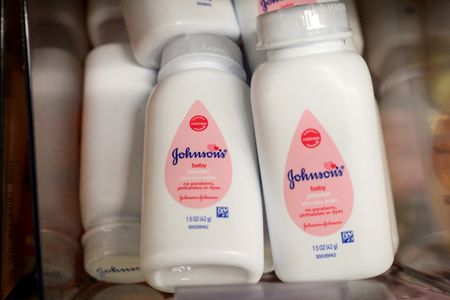By Dietrich Knauth
(Reuters) – Johnson & Johnson’s proposed $8.9 billion settlement of thousands of lawsuits alleging that its talc products cause cancer faces a crucial hurdle this week as a U.S. bankruptcy judge in New Jersey considers whether or not a J&J subsidiary may resolve them by filing for bankruptcy a second time.
J&J subsidiary LTL Management’s first attempt to do that was dismissed in April after a U.S. appeals court ruled that it was not in sufficient financial distress to be eligible for bankruptcy protection.
LTL quickly filed for bankruptcy again, arguing that its second effort has won more support from plaintiffs for a comprehensive settlement of current and future lawsuits alleging that J&J’s baby powder and other talc products sometimes contained asbestos and caused mesothelioma, ovarian and other cancers. J&J has said its talc products are safe and do not contain asbestos.
Attorneys representing cancer victims, along with the U.S. Justice Department’s bankruptcy watchdog, have called for LTL’s second bankruptcy to be dismissed as an abuse of U.S. bankruptcy law. Cancer victims who oppose the bankruptcy settlement have said that the second bankruptcy recycles a failed legal strategy to keep their cases from being heard by juries.
Starting on Tuesday, U.S. Bankruptcy Judge Michael Kaplan in Trenton is due to hear several days of evidence and arguments before making a ruling. Kaplan, whose decision in support of LTL’s first bankruptcy filing was overturned by the Philadelphia-based 3rd U.S. Circuit Court of Appeals, has said he expects to rule on whether to dismiss LTL’s second bankruptcy by early August.
LTL executives including chief legal officer John Kim are expected to testify on Tuesday. Jim Murdica, a lawyer who took part in negotiations on the $8.9 billion settlement on behalf of LTL and J&J, and Mikal Watts, a lawyer for some plaintiffs, are expected to testify on Wednesday.
Erik Haas, J&J’s worldwide vice president for litigation, said in a statement last week that the proposed bankruptcy settlement offers a fairer and faster resolution for cancer claimants than litigation in other courts.
The attorneys who oppose J&J’s settlement offer argue that J&J created the “illusion” of support by signing deals with plaintiffs’ lawyers like Watts, who quickly signed up large numbers of clients without ever filing any lawsuits against J&J.
LTL’s bankruptcy proceedings have paused the 38,000 lawsuits that were filed before October 2021. Kaplan has ruled that the second bankruptcy does not fully stop the talc litigation, letting one plaintiff’s case to go to trial and allowing new complaints to be filed against LTL and J&J as long as no other trials are scheduled without permission from the bankruptcy court.
U.S. bankruptcy law typically shields debtors from lawsuits while they reorganize in bankruptcy. Bankruptcy judges have not always extended those protections to non-bankrupt parent companies like J&J.
(Reporting by Dietrich Knauth in New York; Editing by Alexia Garamfalvi and Will Dunham)





